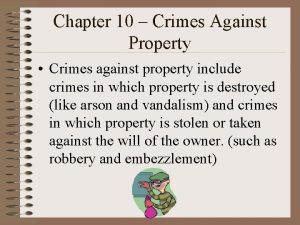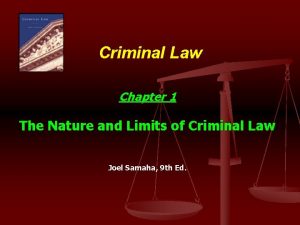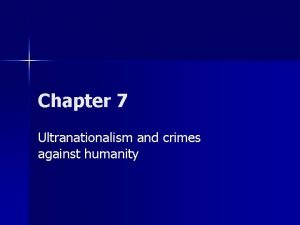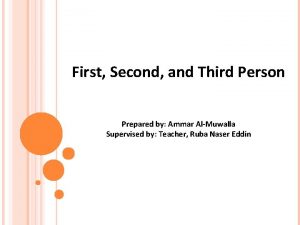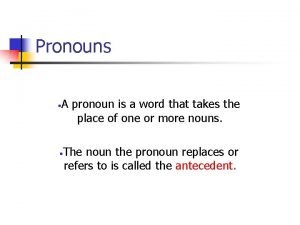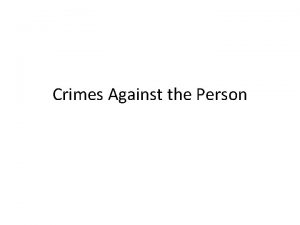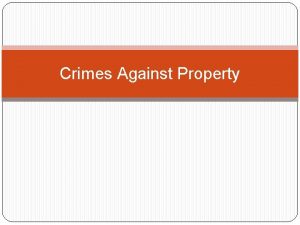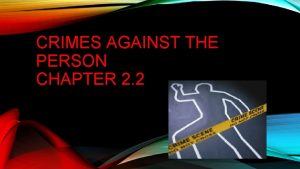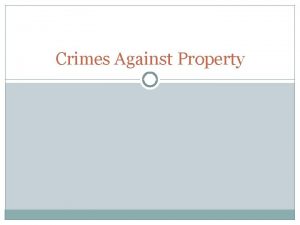Chapter 9 Crimes Against the Person Eliseo Lugo











- Slides: 11

Chapter 9 Crimes Against the Person Eliseo Lugo III

Objectives: By the end of class, students will be able to: n n n Differentiate between first degree murder, felony murder, and second degree murder. Differentiate between Voluntary and Involuntary manslaughter. Cite examples of negligent homicide and noncriminal homicide. Analyze various scenarios to determine which type of homicide has occurred. Define what constitutes malice and its place in determining which homicide has occurred.

Homicide n n n Homicide – the killing of one human being by another. Can be criminal or noncriminal Criminal Homicide – is killing that is done with malice. All homicides done with malice used to be punishable by death. Now they are classified by state of mind and/or circumstances.

Degrees of Homicide n n n First-degree murder – is murder that is premeditated and done with malice. Felony Murder – murder that is done during the commission of certain felonies. Examples – Shoot someone during a robbery, kill someone during a rape attack. Second-degree murder – killing that is done with malice, but is not premeditated. Examples include – road rage, etc.

Degrees of Homicide Continued n n Voluntary Manslaughter – a killing that would be a murder, but the victim has done something to make the killer lose control. Example – a husband kills his wife after finding her in bed with another man. Involuntary Manslaughter – a killing that results from actions that were so reckless that they resulted in the killing of a person. Example – street racing, playing with a loaded gun.

Homicide Continued n Negligent Homicide – homicide that is caused by a negligent action. Negligence is the failure to exercise a reasonable or ordinary amount of care in a situation that causes harm to someone.

Objectives: By the end of class, students will be able to: n n Define the term : Suicide Describe the legal consequences for those who assist someone else in committing suicide. Identify statistics that underscore why teen suicide is of serious concern. Identify resources that are available to people who feel suicidal.

Suicide n n n Suicide is the deliberate taking of one’s own life. Courts now treat this as a cry for help. They are usually required to seek mental help. Helping someone commit suicide is a crime and can be considered murder or manslaughter.

Objectives: By the end of class, students will be able to: n n Explain how the charges relating to kidnapping change of the abductor brings a person across state lines. Describe the significance of actual injury in the crimes of assault and battery. Illustrate how differing degrees of seriousness are reflected in legal classifications of types of assault and battery. Define the terms: kidnapping, unlawful imprisonment, abduction, assault, battery, cyberstalking, and bullying.

n n n Kidnapping was originally referred to as the stealing of children for use as servants or workers. Kidnapping involves the taking away of a person against their will. If taken across state lines, the crime becomes a federal crime. Kidnapping

Assault and Battery n n n Assault is the threat or attempt to carry out physical harm. “I am going to kill you” Battery is unlawful physical contact inflicted on one person onto another without consent. Example – If I punch you in the face and you don’t give me permission to.
 Street law chapter 9 crimes against the person
Street law chapter 9 crimes against the person Crime against property
Crime against property What are the crimes against public order?
What are the crimes against public order? What are the crimes against public order?
What are the crimes against public order? How does ultranationalism lead to crimes against humanity
How does ultranationalism lead to crimes against humanity Crimes against society
Crimes against society Singular 2
Singular 2 Third person and first person
Third person and first person Person person = new person()
Person person = new person() Is the word that a pronoun
Is the word that a pronoun Istituto san giuseppe lugo
Istituto san giuseppe lugo Silvia lugo murder
Silvia lugo murder

